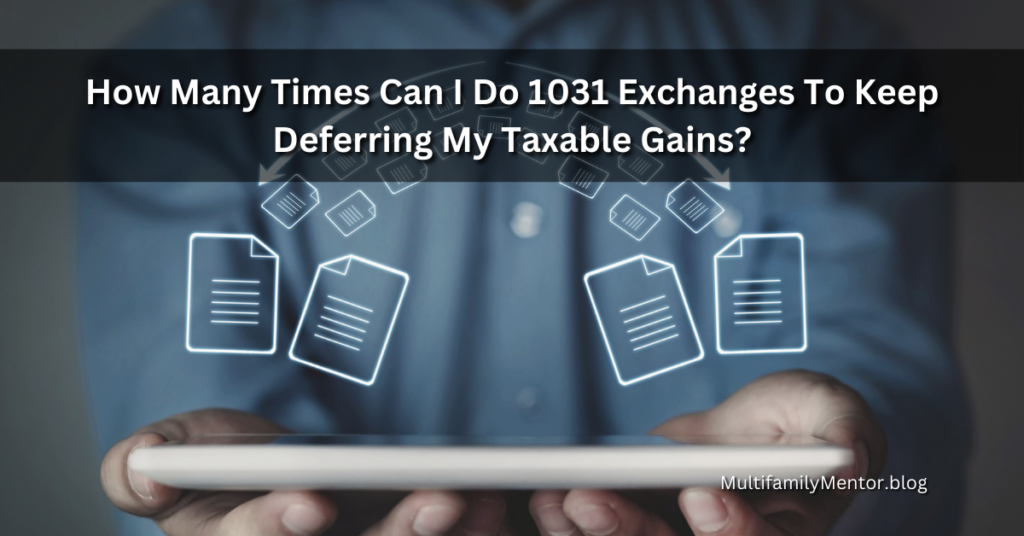Take control of your tax planning with multiple 1031 exchanges. Maximize your investment returns and keep deferring taxable gains. Get started today!
Executive Summary
In this essay, we'll dig into the world of 1031 exchanges and consider if it's possible to use this tax method repeatedly to postpone the realization of taxable gains. Real estate investors can postpone capital gains taxes by reinvesting the sale profits of an investment property into a like-kind property through a 1031 exchange. However, the frequency and eligibility for repeated 1031 exchanges are governed by certain laws and restrictions. Investors can make wise selections to maximize their tax planning techniques by being aware of these regulations.
Introduction
The potential tax advantages of 1031 exchanges frequently pique the interest of real estate investors. Their investment returns can be greatly increased by having the option to postpone capital gains taxes. However, the question of how frequently one can participate in 1031 swaps to continue delaying taxable gains emerges. We must investigate the subtopics that clarify the restrictions and prerequisites related to 1031 exchanges in order to find the answer to this query.
1031 Exchange Eligibility Requirements
To start a voyage of several 1031 exchanges, it is crucial to comprehend the prerequisites. The following are some crucial considerations:
- The exchanged property must be kept as an investment or utilised in a trade or business.
- Like-kind property, which often relates to the type or character of the investment, must be present in both the relinquished property (sold property) and the replacement property.
- The investor must find and buy the replacement property within a specific window of time.
- Stocks, non-real estate assets, and personal dwellings are not eligible for 1031 exchanges.
The 45-Day Identification Rule
The 45-day identification rule is an important component of 1031 exchanges. The investor must find prospective replacement properties within 45 days of the sale of the property given up. As it relates to this rule, keep the following in mind:
- An investor must give a qualified intermediary or other pertinent parties participating in the exchange a written and signed identity notification.
- The prospective replacement properties must be specifically included in the identification notice.
- If their combined fair market value is less than 200% of the value of the relinquished property, the investor may name up to three properties, each of any value.
- The exchange's ability to be tax-deferred may be in jeopardy if the 45-day identification deadline is missed.
The 180-Day Exchange Period
The 180-day exchange period is a crucial additional consideration. The Investor shall complete the acquisition of the Replacement Property within such period. Important specifics concerning this rule are as follows:
- The moment the sold property is relinquished, the timer begins to run.
- By the earliest of the 180th day or the tax return due date, the investor must purchase the replacement property.
- To postpone any taxable gains, the replacement property must be worth at least as much as the property that was given up.
- If the replacement property is of lower value, partial swaps may result in taxable gains on the difference.
Applying the Step-Up in Basis
Investors may want to think about using the step-up in basis to maximize the advantages of several 1031 conversions. What you need to know is as follows:
- Investors can recalculate the cost basis of their investment properties to reflect the replacement property's fair market value thanks to the step-up in basis.
- A stepped-up basis may be available to an investor's heirs if they hang onto the replacement property until their passing. This could result in a complete avoidance of capital gains taxes.
- If you want to transfer wealth over generations, this technique may offer long-term tax benefits.
The Continuous Exchange Interpretation
The idea of “continuous exchanges” has evolved, even though the Internal Revenue Code does not specifically place a cap on the number of 1031 exchanges a shareholder may complete. According to this theory, the IRS may examine frequent exchanges as a collection of connected transactions rather than as discrete, independent exchanges. The following are crucial considerations:
- In order to establish whether the exchanges truly qualify as independent transactions, the IRS focuses on the exchanges' intention and purpose.
- The IRS may contest the tax-deferred status of subsequent exchanges if an investor is determined to be involved in a continuous exchange.
- To make sure that all 1031 exchanges are compliant with the laws and regulations, each transaction must be examined separately.
Conclusion
Although there is no cap on the number of 1031 exchanges a shareholder may participate in, a number of factors affect the viability and success of numerous exchanges. The outcome is affected by eligibility requirements, stringent deadlines, step-up in basis strategies, and the idea of continual exchanges. Real estate investors must carefully collaborate with skilled intermediaries and tax experts to handle the complexities of 1031 exchanges and guarantee IRS compliance.

